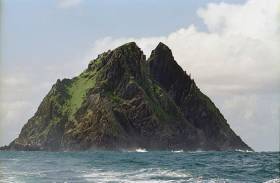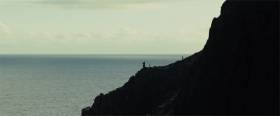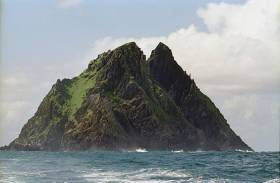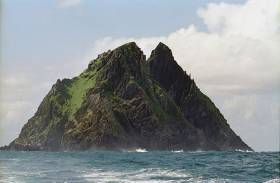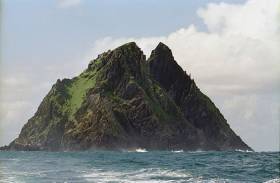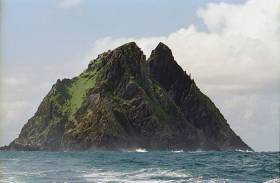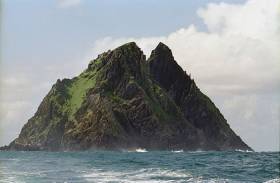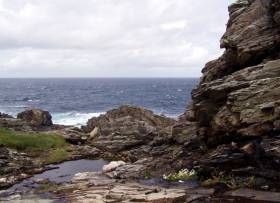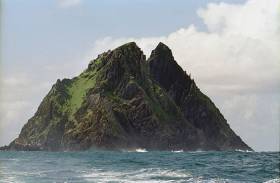Displaying items by tag: Skellig Michael
Skellig Boatman In Court Action Over Landing Limits
#SkelligMichael - Skellig Islands boatman Sean ‘Seanie’ Murphy has brought a High Court action over limits on the visitor season at Skellig Michael, as BreakingNews.ie reports.
Murphy claims the move by the Department of Transport, Tourism and Sport to move the opening of the season from the traditional 30 March to mid May, when the island is staffed, has reduced the summer landing period by a third.
He also argues that the Transport Minister is not entitled to determine the length of the landing season, noting that the decision — apparently taken on health and safety advice from the National Monument Service, which staffs the island — was made without consultation with boatmen who ply the route to the island off the Kerry coast.
Poor weather postponed the opening of the island to visitors till this past Thursday 18 May, as RTÉ News reports, after earlier concerns that unstable rocks on the island would cause further delays.
Previously, another boatman challenged the loss of his landing permits at the Unesco World Heritage site that’s set for a tourism boom with its connections to the new Star Wars film series.
Skellig Michael Opening In Doubt Over Unstable Rocks
#SkelligMichael - Skellig Michael’s opening for summer visitors on 14 May has been cast into doubt by concerns over of a number of unstable large rocks following a rockfall discovered earlier this month.
Safety contractors and OPW staff are currently assessing the situation at the Unesco World Heritage site, a major location in the upcoming blockbuster movie Star Wars: The Last Jedi.
But according to The Irish Times, the filming activity and increased visitor numbers are not to blame for the damage on what’s been dubbed ‘Star Wars Island’ — more likely caused by heavy winter storms and burrowing by the island’s rabbits.
As previously reported on Afloat.ie, evidence of a “deeply worrying” rockfall was found during pre-season checks by OPW staff on Friday 7 April.
Concern Over Skellig Michael Rockfall
#IslandNews - A serious rockfall on Skellig Michael has been described as “deeply worrying” by a senior conservationist.
RTÉ News reports that the rockfall was discovered during pre-season checks by OPW staff last Friday (7 April), close to accommodation huts on the Co Kerry island’s Lighthouse Road.
The Unesco World Heritage site is due to open for visitors next month, with big numbers expected in the wake of its featuring in the new Star Wars movies.
OPW senior conservation architect Grellan Rourke said that if some of the “very large” rocks had come down on top of the huts “there would have been a significant threat to anyone inside”.
Experts will examine the rock slopes in question, with no confirmation of whether this would affect Skellig Michael’s opening date for visitors.
RTÉ News has more on the story HERE.
Skellig Ring Makes Top 10 World Travel Regions
#SkelligRing - The Skellig Ring in Co Kerry features in Lonely Planet’s top 10 regions for globetrotters to explore on 2017.
“Ireland’s most charismatically wild and emerald stretch of coastline,” as the popular travel guide’s Best in Travel report puts it, rounds out a list that includes such breathtaking destinations as French Polynesia, Chilean Patagonia, mountainous New Zealand and the Azores.
And unsurprisingly, the biggest draw to this corner of the Wild Atlantic Way is the majestic Skellig Michael, set for another bumper tourism year in 2017 on the back of its inclusion in the new Star Wars movie series.
Skellig Michael Drone Film Shoot Criticised
#SkelligMichael - The Department of Heritage has approved a film shoot by drone at Skellig Michael, despite the use of drones being prohibited on the island.
According to The Irish Times, a guide on the Unesco world heritage site has raised concerns that permission for the Fáilte Ireland shoot would make a general ban on the use of drone aircraft by visitors difficult to enforce.
“How can we instruct the public not to fly drones if it will be clear that a tourism body has been permitted to do this extensively?” said the guide, who claimed anonymity.
Previously, an experienced guide spoke out over the controversial Star Wars shoots on the island last year.
The filming for box office hit The Force Awakens and next year’s Episode VIII attracted worldwide attention to the Co Kerry islands, which have since been promoted as a tourism attraction for Star Wars fans by Fáilte Ireland.
The Irish Times has more on the story HERE.
#SkelligMichael - A longtime boatman plying the Skellig Michael route for visitors has mounted a High Court challenge against the loss of his landing permits, as The Irish Times reports.
The Office of Public Works (OPW) revoked two permits from Sean Feehan in January following his conviction of offences under the Merchant Shipping Act relating to passengers becoming ill on the boat trip to the iconic Kerry island, as detailed in the Irish Examiner.
But Feehan argues that the OPW's action was unconstitutional, citing his "exemplary" record overall since he began ferrying passengers to Skellig Michael in 1980, and adding that other boatmen found guilty of similar safety offences had not lost their licences.
Business is expected to boom in the coming months for Skelligs boatmen due to the islands' prominent role in the new Star Wars film series – though recent rockfalls at the Unesco World Heritage site mean it's a place for experienced skippers only.
The Irish Times has more on the story HERE.
Storm Damage Repairs Prioritised For Skellig Michael
#SkelligMichael - Repairs to storm damage on Skellig Michael are a priority ahead of the summer tourism season, as RTÉ News reports.
The OPW will oversee repairs to six metres of a wall between the pier and the island's South Steps, much of which has collapsed into the sea following the recent stormy winter.
Until repairs are completed, the Unesco World Heritage site has been declared unsafe for tourist landings – many thousands of which are expected this year after the rocky outcrop featured prominently in December's cinematic blockbuster Star Wars: The Force Awakens.
Filming on Skellig Michael for that and future Star Wars films has also been a source of controversy, with an experienced island guide speaking out recently over the impact of filming on the ancient monastic site and its vulnerable marine wildlife habit.
RTÉ News has more on the story HERE.
Star Wars Shoot Coming To Malin Head? Not So Fast, Says Govt
#StarWars - Rumours that Star Wars film crews are set to decamp for the Donegal coast are just that, as the Government department responsible has not confirmed permission.
According to TheJournal.ie, location scouts for Lucasfilm have been spotted in the Malin Head area searching for appropriately dramatic vistas for future instalments of the epic sci-fi film series.
But while Heritage Minister Heather Humphreys has confirmed that a "limited amount of filming" will take place on Sybil Head in Dingle later this year, no such permission has been granted for Donegal – and the minister would not comment on the existence of any talks over the same.
Star Wars fever has gripped the Kerry coast since last year as the Skelligs featured prominently in the smash hit blockbuster The Force Awakens.
But the filming has not been without its share of controversy over repairs to monastic ruins and alleged interference with protected seabird species at the Unesco World Heritage site.
More recently, a long-time guide on Skellig Michael spoke out over the State's facilitating of the two Lucasfilm shoots on the island for The Force Awakens and next year's sequel, as previously reported on Afloat.ie.
Island Guide Speaks Out Over Skellig Michael Star Wars Shoot
#StarWars - An experienced heritage guide's concerns have rekindled controversy over the impact of filming for the new Star Wars movies on Skellig Michael.
As The Irish Times reported recently, Claire O’Halloran – an independent contractor for the Office of Public Works (OPW) on the Kerry coastal island over the last 28 years – claims that damage to the Unesco World Heritage site has been downplayed, with many "control failures" going unreported.
She alleges that Arts and Heritage Minister Heather Humphreys granted permission for the film shoot based on incomplete data on the ecology of the island, a sanctuary for important seabird species.
It's also a location that's being hyped by Tourism Ireland on the back of its featuring in the recent blockbuster hit The Force Awakens.
But O'Halloran reserves much of her ire for the Irish Film Board, which comes under the auspices of the minister.
According to the island guide, the board seemed “completely unaware” of the island's sensitivity as it pushed for the shoot with Disney Lucasfilm – with initial plans for the summer of 2014 providing for a crew of 300 and air-drops of additional equipment before any consultation with the National Parks and Wildlife Service.
The Irish Times has much more on the story HERE.
#StarWars - Tourism Ireland is hoping the success of the new Star Wars movie will attract fans in their droves to Skellig Michael and the Kerry coast, as TheJournal.ie reports.
And the tourism marketing board has launched a new video extolling the virtues of the UNESCO world heritage site, which will play a big role in Episode VIII of the Star Wars saga due in cinemas in May next year.
But not everyone will be happy with the growing interest in the vulnerable island habitat for many protected marine species, coming just weeks after Birdwatch Ireland said the most recent film shoot on the island was "not compliant" with the EU habitats directive.


























